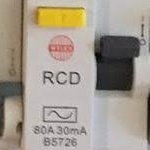
RCD - Residual Current Device
A RCD is a protective device that will switch the circuit off in the event of a leakage of current out of the system. The most common RCDs will trip when a leakage of 30mA is detected. A typical socket circuit will trip at 32A, so the RCD is over 1,000 times more sensitive. It has been designed primarily for personal protection, to reduce the current flow in the event of an electrical shock.
There are many reasons why your RCD can keep tripping. It is important to eliminate the most common causes of the tripping of the RCD before calling upon the services of an electrician. Often the fault is not in the wiring and these faults may not be detectable during an inspection and test of the circuits.
The actual mechanism of a RCD to trip is the leakage of current outside of the live and neutral conductors. The energy may pass through the earthing conductors within the property, the fabric of the building or even people within the building. Disturbances in the circuits can also cause a RCD to trip. These disturbances are frequently caused by worn out motors.
RCD’s and MCB’s have different ways to protect property and life. MCB’s protect against electrical faults that are due to high currents so that they will trip due to faults such as short circuits or overcurrent. RCD’s are very sensitive and are there to protect against the earth to neutral faults and issues such as current leakage. For example, the RCD might trip due to detecting even a small current leakage, but at a level that is below the rating of the MCB rating; this meaning that the MCB would not trip.
Please remove appliances from the circuit and leave disconnected for a period of time. If the RCD trips while the appliance is disconnected, then it is likely that the appliance is not at fault.
You may also notice that your RCD trips only when a certain appliance is connected and in operation.
This can be difficult for fridges and freezers as these need to be permanently connected. For these appliances it may be possible to move them to a different circuit served by a different RCD by moving the appliance or use of an extension lead.
All appliances can cause an RCD to trip; fridges and freezers use motors which wear out. Washing machines also have motors and also have water both in the washing area and condensation within the frame of the machine due to cold parts when not in use. Cookers have heating elements that break down over time and will allow electricity to flow through the earthing.
Please note that appliances do not need to be old to have faults. Brand new equipment can be poorly constructed which will cause issues immediately or shortly after first use.
Any water or moisture within your electrical system can cause RCDs to trip. This is as the RCD operates at a low fault current, in effect providing advanced warning of a serious fault. In many cases the RCD can be reset a number of times before the fault becomes significant. This is not to belittle the seriousness of the early detection of the fault, and you should have any fault investigated.
Moisture ingress is most common in external areas as well as kitchens and bathrooms. In kitchens when cooking steam particles can carry grease into switches and sockets, which will cause RCDs to trip. Additionally sockets above worktops are commonly cleaned leading to water entering the socket. Care should always be taken when cleaning sockets to prevent any water entering the face of the socket.
Over time electrical connections become weakened through vibrations and the heating and cooling of the joints. A poor connection can cause an RCD to trip. It is possible to detect some poor connections by electrically testing the circuit. This is something that an electrician will be able to investigate.
Most commonly faults are discovered in installations that have not been maintained. It is important to have your electrical installation regularly maintained. The recommended maximum period between the inspection and testing of an installation is five years for rental property and ten years for owner occupied for domestic installations. For the majority of non-domestic installations the maximum period is five years.
Summary
The first objective is to try to locate the fault in an appliance. If you are unable to establish that equipment is causing the fault, please call an electrician to locate and repair the fault.
If you have not been maintaining your electrical installation, please call an electrician to carry out an Electrical Installation Condition Report (EICR). This will both provide peace of mind that your home or business has been tested and also, perhaps more importantly, the testing may identify faults that are easy and cheap to fix now that could cause significant issues and cost later.
Click here to read more about electrical terms

Solid Electrical is part of Solid Franchising, the development partner for tradesmen and tradeswomen across the country.
Copyright © All Rights Reserved